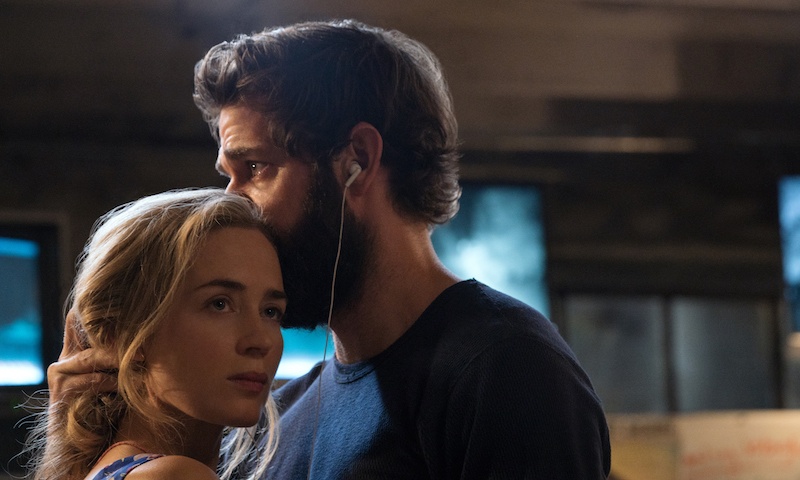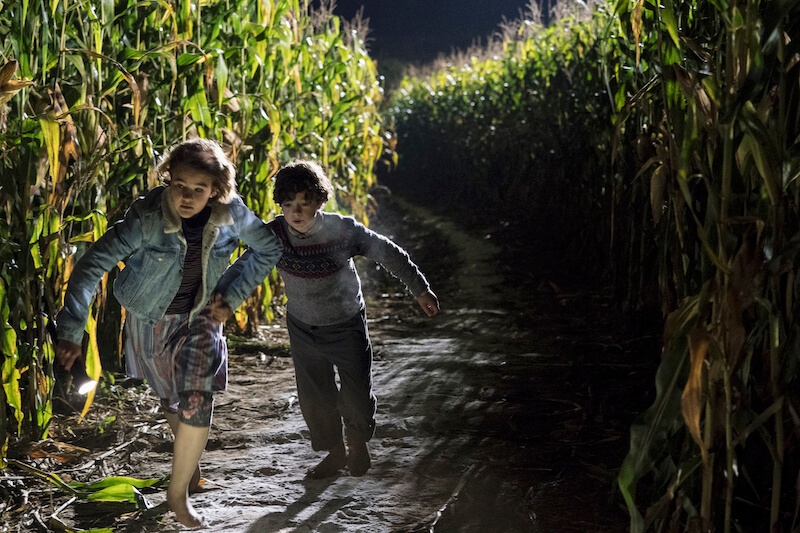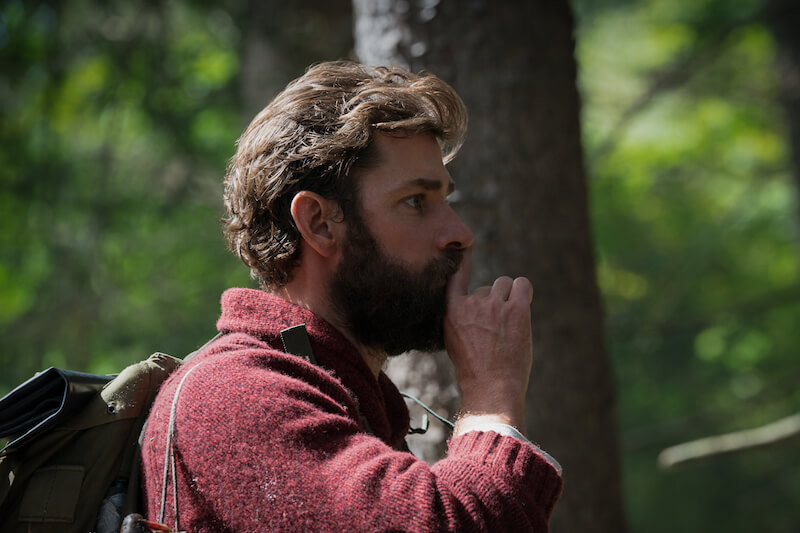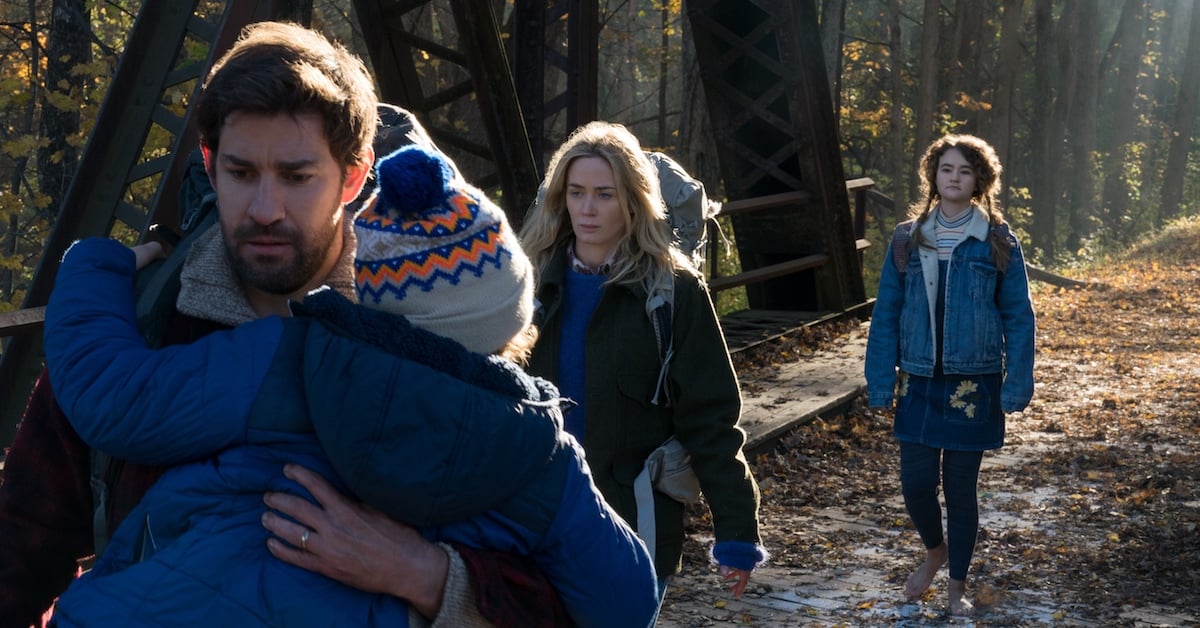by Vinny Alfano
Learn about the intricate and risky sonic decisions made while creating the sound of A Quiet Place.
Watching A Quiet Place will make you feel more like a participant than a spectator. A family of five in a post-apocalyptic world must try to survive while vicious creatures are on the hunt for anything that makes a sound - shhh! Since its release, the movie has achieved critical acclaim, and its bold use of sound has made quite a stir.
We had the honor and pleasure of speaking with Supervising Sound Editors Erik Aadahl and Ethan Van der Ryn about their sound contributions to A Quiet Place. They discuss the film's use of silence, collaboration dynamics, popcorn snackers, and more.
Warning: Contains spoilers.
Images from film courtesy of Paramount Pictures
Tell me about your collaboration with director John Krasinski. How was the direction for the sound of the movie developed?
Ethan Van der Ryn: We met with him initially and it was more of a brainstorming; talking about what we thought would be cool to try and play with, and John had a lot of ideas on different things to focus on. We had a bunch of ideas floating around. When we first got the cut of the movie, he actually asked us if he should come and spot the movie with us. We said we'd actually rather just sit with the movie for a few days to start working on it, and then sit with him. I think that was a good approach because it allowed us to feel it out in our own way, then present some ideas to him.
Erik Aadahl: Our first pass was more experimental, really - trying to come up with solutions to some of the key concept challenges with the sound design. The first of them being the daughter, Regan. As scripted, she's deaf with a cochlear implant - sort of like a hearing aid. The actress playing her, Millicent Simmonds, is also deaf. There was an authenticity that was just baked in from the start. It was really important to us to try and create her sonic perspective, her point of view..jpg?width=800&height=450&name=ethan-van-der-ryn-erik-aadahl%20(1).jpg)
Ethan Van der Ryn and Erik Aadahl
Aadahl: So for our first experiment, the very first sequence we started working on was the opening of the film - going from the pharmacy to the trestle bridge where the families first experience an attack. With all of her close ups, we thought to try to sonically explain her point of view by creating what John ended up terming her “envelope." So when the cochlear implant is turned on, it's not totally silent. There's this kind of low hum. We started with going straight from the atmospheres into her low hum when we cut to her perspective. The very first cut that we were given had temp music going through her shot, so we pitched to John, "Let's take out the music." We needed to really start ripping things out for that concept to be clear. Fortunately, John is so adventurous and got really excited about that. It was one of the first puzzles we unlocked. Another thing that John really wanted us to focus on in the beginning was the cochlear implant and how it interacts with the creatures. It’s a key sonic story point of the film.
The second sequence we started working on was a cornfield scene at night where the daughter first has a close up interaction with the creature. We did it all - there's no dialogue, there's no music. It's all about sound sort of explaining this logic of her hearing aid and how it starts to interfere and feedback in proximity to the creatures. Once we unlocked that puzzle piece in the sound design, it helped inform how we approached the rest of the movie.
It wasn't a slam dunk right away, but we got it close enough to where we started to realize the sound now really affects the picture editing, so the picture then would start to get cut to our sound. Even the visual effects, where we first go into the ear of this creature, we realized we had to extend some of those so we had enough time, sound-wise, to show the evolution and blossoming of what the creature is experiencing as well from its heightened sound of the cornfield that then evolves into this sound of hearing aid interference in the same shot.
By forcing people to really lean in and adjust their own behavior to what's happening on screen, it forces them to become participants in what's going on and turns it into a more interactive and engaging experience.
.jpg?width=800&height=533&name=aqp18441r%20(1).jpg)
Left to right: Noah Jupe, Millicent Simmonds, John Krasinski
Van der Ryn: When we started working on this sequence in the cornfield, where we're basically trying to convey this key plot point about how the hearing aid interferes with the creature, we knew we needed to hear it from the daughter’s perspective but thought it would be cool to hear it from the creature's perspective as well - to create this equivalent sonic envelope for the creature. So we can really experience what each one of these characters is experiencing. This isn't anything that was baked into the script. It's sort of the key concept that we discovered as we started working through the scene. Once we cracked that nut for that scene, we realized it would apply to other areas of the film and be an extremely useful tool for getting through the story.
Just to expand on that point, the daughter actually has two separate sonic points of view. Two separate envelopes. One when her cochlear implant is turned on, and another when it’s off - which I think for both me and Erik was one of the most stunning parts of the film sonically. These are the only moments in the film where we go to complete silence, digital zero.
I noticed that and absolutely loved it!
Van der Ryn: The moments when she actually has her hearing aid turned off… there’s something so strange. As people, we're not used to hearing total silence anywhere, anywhere in the world. Especially not in a movie theater. There's something so unsettling about that.
It’s also very emotional because it connects us in a really deep and instant way to the daughter’s experience of the universe. On a gut level, we instantly get what her experience is. Or at least a little bit more of what her experience is in a way that could never be explained. I think that's sort of what makes it so powerful.
As people, we're not used to hearing total silence anywhere, anywhere in the world. Especially not in a movie theater. There's something so unsettling about that. It’s also very emotional because it connects us in a really deep and instant way to the daughter’s experience of the universe.
.jpg?width=800&height=533&name=aqp07531r_0%20(1).jpg)
Emily Blunt and Millicent Simmonds
How much did you consider the potential audience noise throughout your process?
Aadahl: It was something that we thought about a lot. Our overall feeling was yes, it's risky to be so quiet. But the potential pay off we thought was just so much bigger. So we all knew we were taking a risk.
There was one thing we did mix-wise to kind of mitigate some of that concern. At the very head of the film - when the audience doesn't quite know necessarily what they're in for, and they're all adjusting to this new experience, and probably ready to crack into their popcorn - we mitigated that by raising the ambient level. There's a little bit of an adjustment period, then we kind of start to strip it away and ease everybody into the movie.
The goal was that, after a few minutes, people in the audience would kind of learn the philosophy and start to become aware of the sounds they themselves were making in the theater. And, ideally, start to really lean forward and open up their ears and listen and enforce their own quietness.
It's funny, we've heard stories about audiences becoming so self-conscious of any noise that they're making once they realize what the film is doing with sound to the point where people are holding their breath and they're afraid to eat a piece of popcorn lest the whole audience turn on them. It's kind of amazing. I would've thought it had been done before, but somehow it hasn’t. So it's pretty thrilling to make sound into such a powerful weapon in this film.
Van der Ryn: I like the idea of having a tool to create a more interactive experience. I think by forcing people to really lean in and adjust their own behavior to what's happening on screen, it forces them to become participants in what's going on and turns it into a more interactive and engaging experience..jpg?width=800&height=533&name=aqp13081r_0%20(1).jpg)
Everyone loves creatures. How did you approach creating the sounds of these creatures? I think I may have heard some door creaks in their screams... IF you can give away that secret sound recipe.
Van der Ryn: Well... we’ve worked on a few different movies with big monsters. And something we learned a while ago, actually in 2014 when we did Gareth Edwards' Godzilla, is to hold back on sharing that. People were always asking us what Godzilla's roar is made of, and we realized we didn't want people to be thinking about the actual ingredients that went into cooking it up. We wanted people just to be able to experience it. We were a little coy then about giving too much detail about exactly what was used, and I think we're gonna be the same way with this one in terms of being too specific about what we used - at least for a little while. But we’re happy to talk more generally about the process that the creatures sound design went through!
John initially talked to us about these creatures having three main modes of operation, with the one main mode being the searching mode when they've heard a sound and now they're trying to find it. They're blind, so essentially the idea was that the creatures are searching through sound with a type of echolocation. That inspired us to start playing around with sounds from animals that use echolocation for navigating through the world, like dolphins and bats. That was the inspiration behind the clicking sounds you hear when they're in their search mode.
Aadahl: Their other modes are what John described as sort of an “idling,” which are these deep, wet, guttural breaths. They're very powerful creatures with their heavy footsteps, and they're kind of like these exoskeletal arachnid crab-like creatures. So their shell's wet joints, movements, and those kind of visceral sounds were a big part of that idling that John described. Then, of course, they get agitated. They're extremely irritated by certain sounds. So that agitation, which evolves into attack mode, is the most intense part of the creature’s vocal spectrum. That was the overall creature approach, in broad terms.
At first, we kind of overdid it. We had a lot of vocals going on and realized that once we started thinning out and stripping a lot of that away, we only had 20% of what we had originally, and it was even more intense and powerful when it was surrounded by quiet. So that was a nice little discovery that we all made together. Less is more when it comes to creature vocals sometimes.
We've learned to never become really precious with any one idea. There's something really freeing about always trying to continue pushing the track through new levels - always questioning if what you're doing is the most effective and being willing to just dump it all and start over.

You two have worked together on a bunch of movies including Transformers, Godzilla, World War Z... How do you go about splitting up the sound supervising responsibilities as a dynamic duo?
Aadahl: Our partnership is super collaborative. Some sound teams like to divide up scenes by splitting up backgrounds and hard FX. Then another person might do the guns, another person might do the vehicles.... We do not work that way at all. We like to take a holistic approach where it's the two of us working together on the big picture of the scene. Ultimately, every sound affects every other sound, so we don't want things to be compartmentalized and then throw them all together before the mix. That's not how we work.
Another part of our dynamic, which I think is why we have stayed partners for so long on so many challenging film jobs, is we are both our hardest critic. I think Ethan and I are harder on our own work than any filmmaker could ever be, which is really thrilling. We've learned to never become really precious with any one idea. There's something really freeing about always trying to continue pushing the track through new levels - always questioning if what you're doing is the most effective and being willing to just dump it all and start over.
Once you're not only comfortable doing that, but kind of excited about doing that, it's really freeing creatively. So Ethan and I have a really unique partnership that way where we delight in making it as hard as possible on ourselves by never being satisfied. We could keep working on a movie like A Quiet Place, we could've happily kept working on it for a whole ‘nother year just seeing what new things we could have come up with. Ultimately it's the release date that just pulls it out of our hands and says, "Okay, you've given birth now. Here's the movie, world." Hope that it works.
If we never had deadlines, we'd never be finished.
Aadahl: Totally. But in a way, having the deadline on this film was probably a blessing in disguise because there wasn't any additional time to second guess things. Certainly from the studio perspective too, there just wasn't time for anyone to start to get nervous about all the risks we were taking. It was this strange benefit to not having more time. We could take these big risks and be bold and then not have a chance to change it..jpg?width=800&height=533&name=aqp09838r_0%20(1).jpg)
Were there any favorite sound moments in the film of yours?
Aadahl: There’s one moment towards the end of the film where both of the kids are in a truck. The daughter's hearing aid starts interfering and fritzing and she switches it off. She looks at her brother, who's played by Noah Jupe, and he gives just this incredible performance where his face just contorts into terror. But it's done with complete silence.
He looks over her shoulder, and we're in her head from her point of view, and she just sees what he's seeing behind her. There's something about the intensity of the performance and the absolute silence which to me feels like a rug is getting pulled out from under you. The alchemy of that still gives me goosebumps thinking about it.
Any other movie might have crazy music score like dun dun, raging at the intensity of this. And here we just inverted it and it's just the absolute opposite. It's shocking. To me it's just thrillingly shocking. So I think that might be my favorite moment.

Van der Ryn: I’m gonna say the scene in the cornfield early in the movie that we described before is one of my favorites. In a similar way that Erik was just describing, this is a scene where we're in Regan's sonic POV, but we see the creature sort of creeping out of the cornfield behind her. There's something so terrifying about being in her head sonically and realizing she can't hear it. But visually, as the audience, seeing it right behind her.
There's something so terrifying about that dynamic. It's something that's totally cinematic. There would be no other way of getting that feeling. We can't get that feeling from reading it in a book, or from hearing it on the radio alone, or from seeing it in a play. It's a unique experience that we could only have in cinema. I love that experience.
It could also be, we could only have that experience if it was decided to be played the way we did it. Like Erik just said, in so many movies that scene would be played with big music scoring the whole thing - which would obviously completely change the experience. By the same token, one of the first things we did for this scene was take out the music to really focus on the experience that this character is having in that moment. Also, the way it was handled and directed by John. I love that scene in particular.
Aadahl: Just to add to that, Ethan, even beyond just a feeling that can only be created in cinema - it could also only be created by having a lead character who's deaf, which is rare. Kudos to John for demanding that the daughter be played by someone who is deaf in real life.
Is there anything else you’d like to add about your sound work on A Quiet Place?
Van der Ryn: I just want to give a tip of the hat to one of our key sound designers on this movie, Brandon Jones. Just love to give a mention to him because he did a lot of the heavy lifting and really creative work on this movie. I want to recognize his contribution.

















